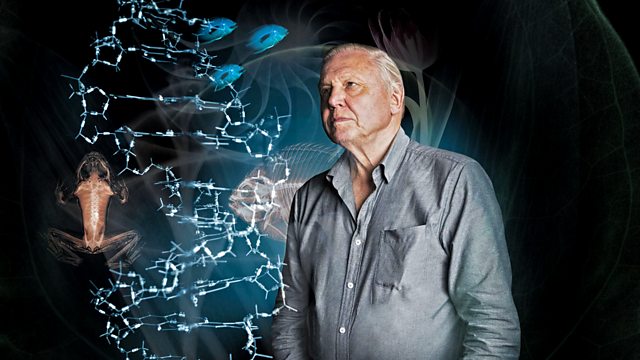Charles Darwin and the Tree of Life: Ever since Darwin, major scientific discoveries have helped to underpin and strengthen Darwin’s revolutionary idea so that today, the pieces of the puzzle fit together so neatly that there can be little doubt that Darwin was right. As David says: ‘Now we can trace the ancestry of all animals in the tree of life and demonstrate the truth of Darwin’s basic proposition. All life is related.’
David asks three key questions: how and why did Darwin come up with his theory of evolution? Why do we think he was right? And why is it more important now than ever before? David starts his journey in Darwin’s home at Down House in Kent, where Darwin worried and puzzled over the origins of life. He goes back to his roots in Leicestershire, where he hunted for fossils as a child and where another schoolboy unearthed a significant find in the 1950s, and he revisits Cambridge University, where both he and Darwin studied and where many years later the DNA double helix was discovered, providing the foundations for genetics.
At the end of his journey in the Natural History Museum in London, David concludes that Darwin’s great insight revolutionised the way in which we see the world. We now understand why there are so many different species, and why they are distributed in the way they are. But above all, Darwin has shown us that we are not set apart from the natural world and do not have dominion over it. We are subject to its laws and processes, as are all other animals on earth to which, indeed, we are related.
Charles Darwin and the Tree of Life
Charles Darwin
Charles Robert Darwin was an English naturalist, geologist, and biologist, widely known for contributing to the understanding of evolutionary biology. His proposition that all species of life have descended from a common ancestor is now generally accepted and considered a fundamental concept in science. In a joint publication with Alfred Russel Wallace, he introduced his scientific theory that this branching pattern of evolution resulted from a process that he called natural selection, in which the struggle for existence has a similar effect to the artificial selection involved in selective breeding. Darwin has been described as one of the most influential figures in human history, and he was honoured by burial in Westminster Abbey.
Darwin’s early interest in nature led him to neglect his medical education at the University of Edinburgh; instead, he helped to investigate marine invertebrates. His studies at the University of Cambridge’s Christ’s College from 1828 to 1831 encouraged his passion for natural science. His five-year voyage on HMS Beagle from 1831 to 1836 established him as an eminent geologist whose observations and theories supported Charles Lyell’s concept of gradual geological change, and publication of his journal of the voyage made him famous as a popular author.
David Attenborough
Sir David Frederick Attenborough is an English broadcaster and naturalist. He is best known for writing and presenting, in conjunction with the BBC Natural History Unit, the nine natural history documentary series that form the Life collection, which form a comprehensive survey of animal and plant life on Earth.
David Attenborough is a former senior manager at the BBC, having served as controller of BBC Two and director of programming for BBC Television in the 1960s and 1970s. He is the only person to have won BAFTAs for programmes in each of black and white, colour, HD, 3D and 4K.




